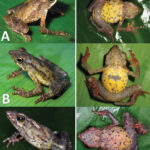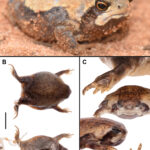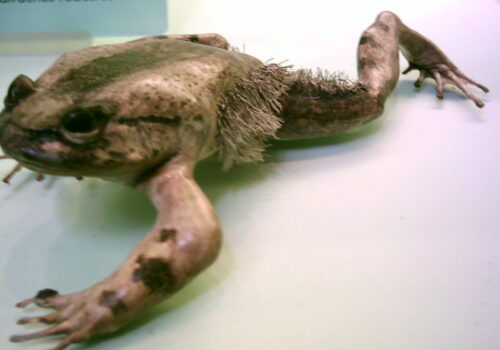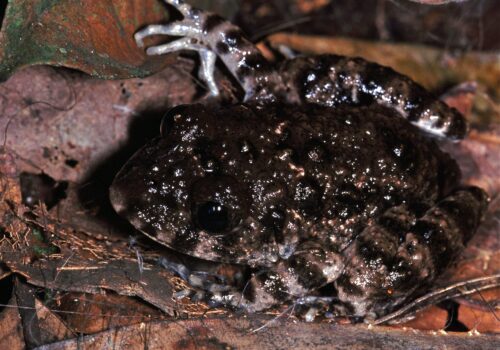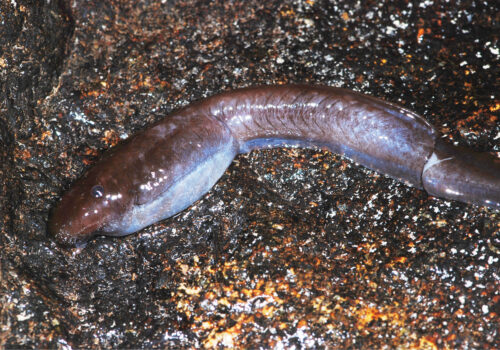Mannophryne yustizi: The Vibrant Stream-Dweller of Venezuela’s Cloud Forest#
Amid the pristine waters and lush vegetation of Venezuela’s northern mountains, hidden amongst the rocky cascades and moss-covered stones, dwells a small yet fascinating amphibian displaying an extraordinary array of behaviors and ecological adaptations—the Mannophryne yustizi. Known for its resounding calls echoing gently through shaded creek valleys, this charismatic little frog embodies nature’s artistry, survival ingenuity, and ecological balance within one delicate amphibious form.
Mannophryne yustizi, a captivating species belonging to the Aromobatidae family, often goes unnoticed by casual hikers due to its modest size and striking camouflage. Yet beneath its humble appearance lies a treasure trove of ecological complexity, intricate social behavior, and a remarkable role that extends far beyond its tiny frame.
Taxonomy and Classification#
Mannophryne yustizi is scientifically classified within the Aromobatidae family, part of the larger group known as Dendrobatoidea. Originally described by La Marca in 1987, the species was initially categorized as Colostethus yustizi before genetic revision saw it relocated to the Mannophryne genus, now recognized distinctly from other dendrobatoid frogs. This reflects a broader understanding of amphibian evolution and biodiversity within South America’s enigmatic cloud forests.
Its closest relatives include Mannophryne collaris, Mannophryne herminae, and Mannophryne vulcano—all species sharing similar ecological niches, behaviors, and extraordinary parental-care tactics in Venezuela’s Andean and Coastal mountain ranges.
Natural Habitat#
Endemic to Venezuela, Mannophryne yustizi thrives predominantly in montane cloud forests and foothill rainforests in the Cordillera de la Costa mountain range. Typically residing between altitudes of 200 to 1,000 meters above sea level, they are strongly associated with pristine forest streams and rocky cascades shaded by a dense canopy of palms, ferns, bromeliads, and robust trees blanketed in moss and epiphytes.
Here, the air is perpetually humid, fed by frequent mountain mists and afternoon showers. These undisturbed ecosystems provide these frogs not only with shelter and water but also with diverse microhabitats essential for their specialized life cycle. Moss-covered rocks offer protective camouflage, while swift-moving streams prevent stagnation and parasites that are potentially dangerous to this delicate species.
Amid gently rushing waters, Mannophryne yustizi can usually be spotted perching quietly on damp rocks, alert and watchful, their colors blending seamlessly into the mottled shadows of the fern fronds and fallen leaves around them. Their habitat choice is not merely aesthetic—it ensures ideal egg-laying sites and successful tadpole development, highlighting how intricately connected their existence is to the clarity and purity of these streams.
Physical Characteristics#
Mannophryne yustizi is a small frog, adults typically measuring no more than 25 millimeters in length. Despite their diminutive size, their presence is marked by distinctive features that fit flawlessly into their niche. With a streamlined form suited for leaping quickly across slippery rocks, their limbs are slender but powerful, enabling sharp and swift movements that leave potential predators baffled.
Coloration and patterning are their primary tools of concealment. Generally, these little amphibians have a dorsal coloration ranging from grayish-brown to tan, punctuated delicately by darker spots and fleck patterns. This nuanced mosaic of colors and textures, reminiscent of fallen leaves and river-pebbled sediments, ensures they remain nearly invisible against their habitat’s backdrop.
Their ventral surface features lighter hues, often subtly marked by pale creams and yellows, an adaptation that likely acts to dissipate reflections of moving water and reduce visibility from predators beneath. Their skin maintains moisture efficiently; a necessity, since prolonged dryness can swiftly endanger their survival. Watching a Mannophryne yustizi move across the landscape is witnessing a fascinating blend of form, function, and seamless adaptation to environmental challenges.
Behavior and Life Cycle#
Feeding Habits and Foraging Strategies#
As daytime-active amphibians, these frogs primarily rely on a curious and opportunistic diet comprising small arthropods such as ants, termites, flies, and springtails. With sharp eyes attuned to the faintest movement, they quickly pounce on prey items that venture into their immediate territory. This insect-based diet not only sustains their rapid metabolism but also contributes significantly to ecological balance, keeping insect populations regulated along forest stream beds.
An Intricate Display of Parental Care#
Perhaps one of the most captivating aspects of Mannophryne yustizi’s behavior is its reproductive strategy, characterized by remarkable parental investment uncommon among amphibians. Males initiate courtship with gentle yet persistent vocalizations near stream margins, carefully selecting calling sites where falling water helps magnify their calls over ambient forest sounds.
Females respond selectively, preferring callers with distinct, clear tones indicating vigor and territory suitability. Following successful mating, eggs are carefully laid alongside shallow, rocky stream edges, providing constant moisture and protection. Astonishingly, unlike many other frog species, the male of Mannophryne yustizi diligently guards the eggs robustly, ensuring their survival until hatching.
Upon emergence from their eggs, the tadpoles partake in another journey of wonder—male frogs gather these tiny larvae on their backs, carefully transporting them through intricate trails to secluded pools, often hidden in small pockets of still water within rocky crevices. Here, away from strong currents and predatory threats, the larvae complete their development safely, metamorphosing over weeks into miniature versions of their attentive fathers.
Ecological Role#
Mannophryne yustizi occupies a critical ecological niche as both predator and prey. Within their forest ecosystem, they contribute significantly by maintaining healthy population controls on insects, directly influencing the balance among invertebrate communities. Conversely, this species also serves as prey to larger predators such as birds, reptiles, and small mammals, thus forming an integral part of the food web.
Most importantly, due to their sensitivity to environmental disruptions, these frogs act as bioindicators—early signals of environmental health or perturbations. A decline in their population often indicates trouble within the ecosystem, such as pollution, toxins, invasive species, or climate-induced habitat changes, thereby providing conservationists and scientists valuable clues regarding ecological integrity.
Threats and Conservation Status#
Despite their significance and remarkable adaptability, Mannophryne yustizi faces increasing pressures primarily from habitat loss attributed to deforestation, agriculture, and urban encroachment. Watersheds across their distribution ranges risk pollution from pesticides and erosion, each of which detrimentally impacts water quality and the delicate ecological relationships essential to them.
Currently, Mannophryne yustizi is classified by the International Union for Conservation of Nature (IUCN) as “Endangered.” Without decisive protective measures aimed at conserving their habitats and maintaining waterway integrity, their future hangs in a precarious balance.
Conservation efforts underway include habitat restoration programs and environmental education initiatives, highlighting the significance of amphibians within each community. By educating local populations and establishing protected regions to safeguard riparian ecosystems, researchers and activists share the collective mission of preserving this incredible forest dweller for future generations.
Cultural and Scientific Significance#
Amphibians, including Mannophryne yustizi, represent profound symbols in local Venezuelan folklore as harbingers of rain and caretakers of freshwater resources. Scientifically, these frogs provide vital insights into amphibian reproductive functions, parental care, and evolutionary adaptability—a biological marvel inspiring numerous ecological and physiological studies informing broader amphibian conservation globally.
Beyond their direct cultural impact and scientific interest, the species illustrates vividly the delicate interconnectivity anchoring ecosystems, emphasizing the need for holistic environmental practices and integrated conservation management strategies.
Conclusion#
Mannophryne yustizi demonstrates vividly the elegance, complexity, and vulnerability inherent in wildlife and ecosystems around the globe. From their enchanting calls resonating through verdant cloud forests to their intricate parental care and indispensable ecological roles, these frogs remind us profoundly of our shared responsibility as stewards of the natural world.
By nurturing respect, awareness, and appreciation for species like Mannophryne yustizi, humanity can ensure thriving ecosystems capable of enchanting present and future generations, preserving nature’s priceless biodiversity legacy. We invite you to become an advocate for amphibian conservation, protecting habitats and raising awareness about these fascinating creatures’ vital role in our natural world.


